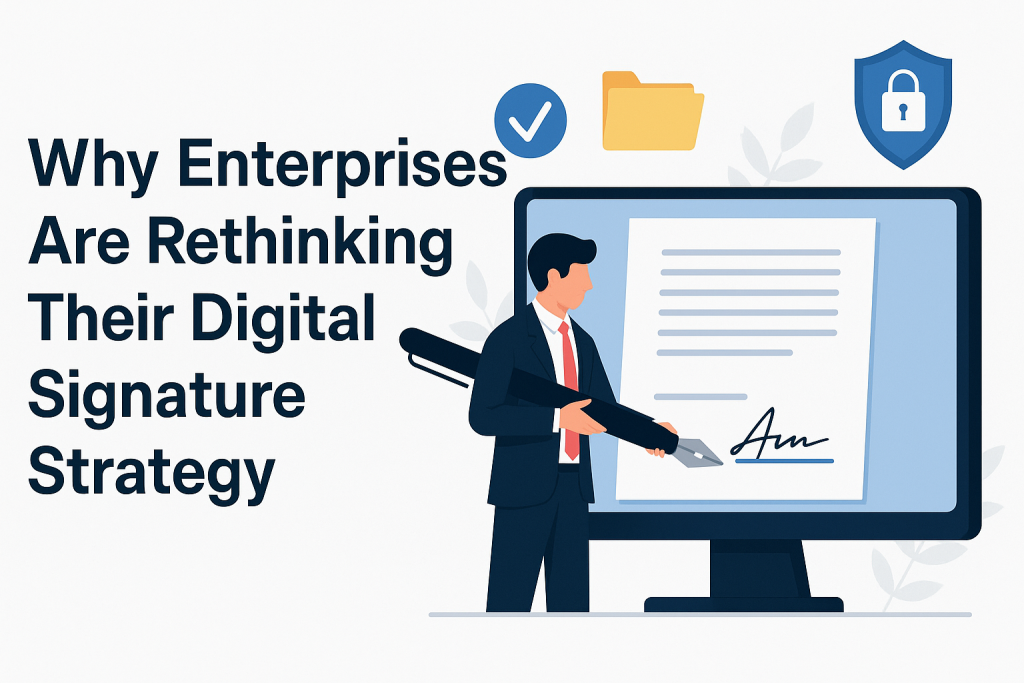Introduction
Enterprises are handling more digital agreements than ever before. Remote and hybrid work models, global supply chains, and cross-border collaborations have made electronic signatures a critical part of daily operations. From HR onboarding to vendor contracts and legal agreements, organizations rely on digital signing tools to streamline processes and maintain compliance.
But as businesses scale, the demands on their eSignature solutions also evolve. Security, scalability, and seamless integration with existing workflows are no longer optional—they’re essential. Enterprises now face a key question: Is their current digital signature strategy truly built for the future?
Industry Challenge: Legacy Tools Aren’t Keeping Up
While eSignature adoption has become standard practice, many enterprises struggle with the hidden limitations of legacy tools. Common challenges include:
- File size restrictions – Complex enterprise agreements often include large attachments like engineering designs, compliance reports, or financial documents, which some platforms fail to handle efficiently.
- Rising subscription costs – As organizations grow, so do the licensing fees for traditional eSignature platforms, putting pressure on IT budgets.
- Integration complexity – Enterprises rely on a mix of ERP, CRM, and collaboration tools, yet many digital signing solutions lack robust integration capabilities.
- Compliance requirements – Expanding into new markets introduces diverse regulatory frameworks that older platforms may not fully support.
These pain points often lead to workflow bottlenecks, increased costs, and potential compliance risks—prompting IT and legal teams to reevaluate their digital agreement strategy.
Existing Solutions: DocuSign, Adobe Sign & Others
For years, DocuSign and Adobe Sign have been the most recognized eSignature solutions in the market. They offer widely adopted platforms with essential signing features that meet the needs of many organizations.
However, as enterprises scale, some limitations become evident:
- Pricing models that escalate with user volume
- Limited flexibility for large or complex document workflows
- Restrictive storage and file upload capacities
- Challenges in deeply integrating with enterprise software ecosystems
For organizations looking for more advanced features, better scalability, and cost savings, relying solely on legacy providers may not be enough. In fact, many decision-makers are now exploring better alternatives to legacy platforms. For a detailed side-by-side look at existing tools, you can refer to this comparison of DocuSign and Adobe Sign.
This shift in thinking has created space for modern, enterprise-focused eSignature platforms that offer more flexibility, security, and value.
A Modern Approach to Enterprise eSignatures
Enterprises that are rethinking their digital signature strategy are looking beyond basic signing features. They want a solution that is scalable, cost-effective, and built for enterprise-grade requirements.
This is where Certinal stands out. Unlike traditional providers, Certinal is designed to meet the needs of modern businesses with:
- 50% more cost-effectiveness compared to legacy platforms, helping enterprises optimize IT budgets without compromising security or compliance.
- Support for file uploads up to 250MB, allowing complex contracts with large attachments to be processed seamlessly.
- 100+ native integrations with leading ERP, CRM, and collaboration tools—ensuring smooth workflows across departments.
- Recognition as a Leader in IDC MarketScape, validating its reliability and innovation in the eSignature space.
- A 4.4 rating on Gartner Peer Insights, reflecting strong customer satisfaction across diverse industries.
This combination of enterprise-ready features and cost savings makes Certinal an attractive alternative for organizations looking to modernize their digital agreement strategy.
Real-World Insights: Why Enterprises Are Switching
Over the past few years, many enterprises have begun migrating away from legacy eSignature tools. The reasons are clear:
- Cost savings on large-scale deployments without compromising on functionality
- Elimination of workflow bottlenecks caused by restrictive file size limits
- Improved compliance with global regulations thanks to advanced security and audit features
- Seamless integration with enterprise ecosystems, reducing manual intervention
For example, multinational firms that handle thousands of agreements monthly have reported significant productivity gains and reduced total cost of ownership (TCO) by transitioning to modern platforms. This growing trend highlights why enterprises are actively exploring better solutions beyond traditional providers.
If you’re evaluating options, it’s worth understanding how newer platforms differ from established players. A detailed DocuSign vs Adobe Sign comparison can help you identify what’s missing in legacy tools and what to look for in a future-proof solution.
Conclusion
Digital agreements are no longer just a convenience—they’re a core part of enterprise operations. But as businesses scale, legacy eSignature tools may not be enough to meet evolving demands for flexibility, security, and cost efficiency.
Forward-thinking enterprises are now reimagining their digital signature strategy with solutions that offer better scalability, stronger integrations, and lower total costs.
If your organization is evaluating how to optimize its digital agreement workflows, now is the time to explore a smarter alternative. Discover how Certinal can help you achieve enterprise-grade eSign capabilities with greater value.
Book a demo today and experience a future-ready digital signature solution built for modern enterprises.

